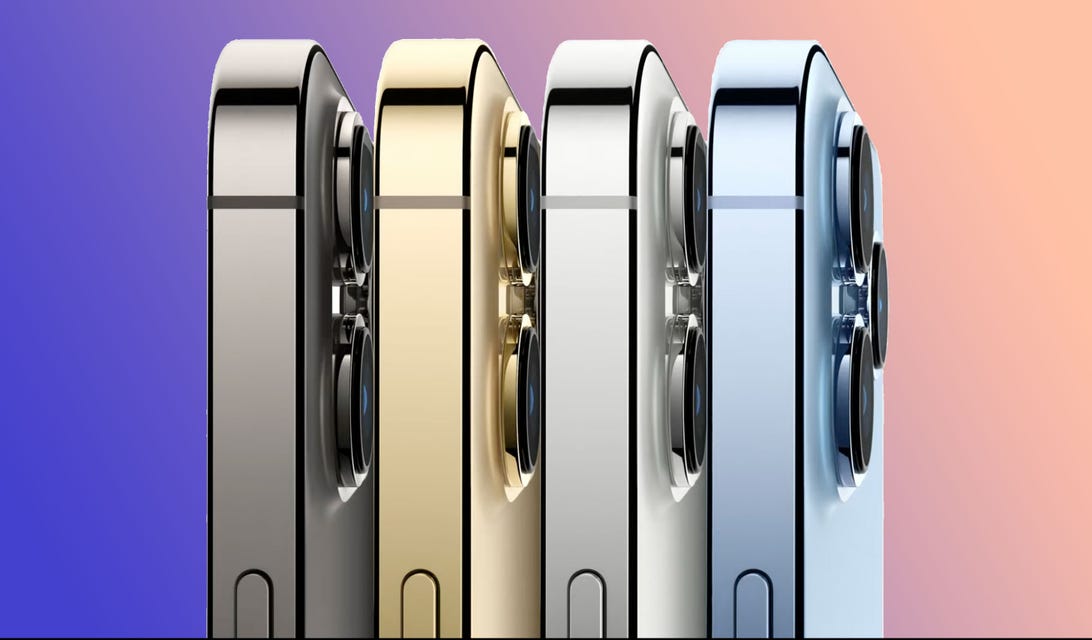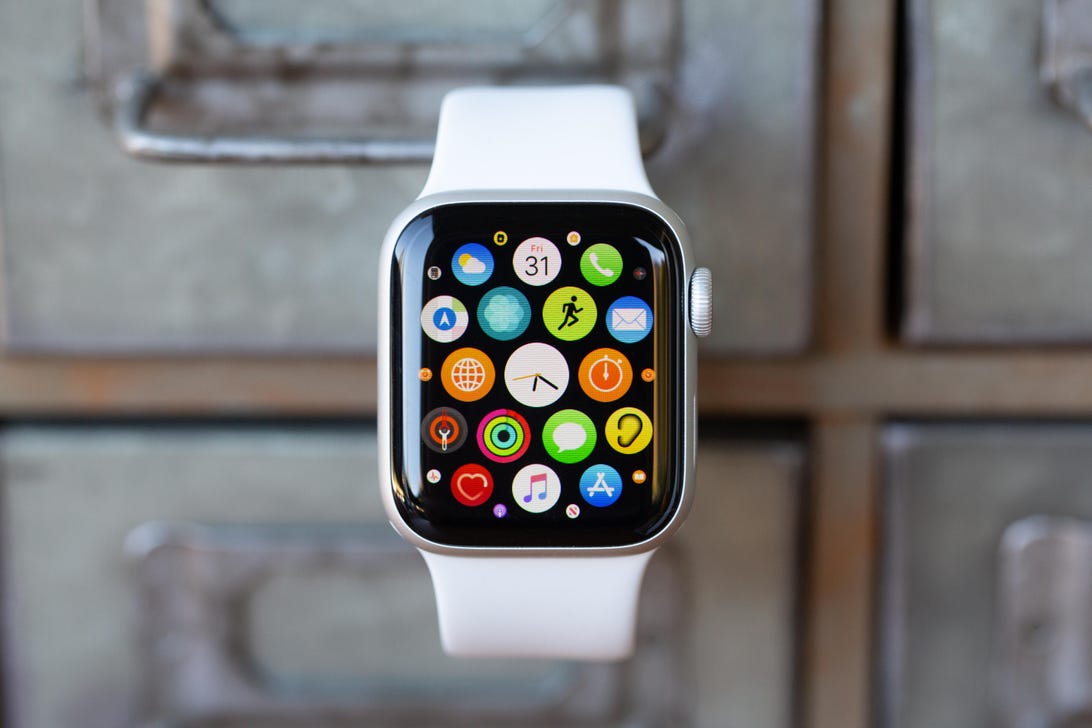
iPhone 13 Pro phones
Apple; illustration by Stephen Shankland/CNETThe iPhone 13 Pro models are the first Apple smartphones to use the ProMotion feature to help graphics and text slide by fluidly when you're scrolling. That means now's a good time to learn about the screen technology called LTPO that enables it.
LTPO stands for low temperature polycrystalline oxide. That mouthful translates to better battery life on premium mobile devices. LTPO allows displays to refresh at high rates when you're playing video games, scrolling through your social media or swiping to change apps. But for static information like e-book text, LTPO can slow refresh rates to save battery power.
On the iPhone 13 Pro and Pro Max, LTPO enables ProMotion's ability to dial screen refresh rates between 10 times per second (10Hz) and 120Hz. ProMotion "produces fast frame rates when you need them and preserves battery life when you don't," Apple's marketing chief, Greg Joswiak, said at Tuesday's iPhone 13 launch event.
Apple isn't the first phone maker to use LTPO. Samsung's Galaxy Note 20 Ultra, Galaxy Z Fold 2 and Galaxy S21 Ultra; Oppo's Find X3 Pro; and OnePlus' 9 Pro all take advantage of the technology. LTPO also is built into some Apple Watch displays.
Here's a look at what LTPO is and how it works.
Why would you want LTPO?
One way to improve smartphones these days is with high refresh rates that rapidly repaint the screen. The usual rate is 60 times per second (60Hz), but high refresh rates can reach 90Hz or 120Hz. The quick refresh rates make for smooth scrolling and help games look their best. But high refresh rates require a lot of power, which is why many phones supporting it allow users to disable it for better battery life.
LTPO helps by gracefully accommodating both high and low frame rates that bottom out at one screen refresh per second for super high efficiency. With an earlier technology called LTPS, short for low temperature polysilicon, displays flicker distractingly at low refresh rates.
"If you want a high refresh rate phone, this is the way to go," Display Supply Chain's Ross Young said of LTPO. "Otherwise it's going to cost you in terms of power."
Apple didn't specifically say it's using LTPO, but it's the only way to deliver ProMotion's abilities on the iPhone, Young said.
What exactly is LTPO?
LTPO is a new way to build the backplane, one of the key layers of a digital display. Backplanes house thousands of transistors, the tiny on-off switches that control how pixels produce light on an adjacent layer in the display.
LTPO is a "best of both worlds" approach to backplanes that performs well when the transistors are on and when they're off. It combines three advantages: high resolution, an adjustable refresh rate and "ultra-low power consumption," said Strategy Analytics analyst Jeffrey Mathews. But it comes with a 5% to 10% price premium.
What it doesn't replace is a display's separate system for generating light, for example backlit light-emitting diodes (LEDs) or active matrix organic light-emitting diodes (AMOLED). So don't be surprised to hear phone-makers say they're using both AMOLED and LTPO.
Why is Apple interested in LTPO?
LTPO is a great match for Apple's ProMotion display technology, which offers variable refresh rates that can reach up to 120Hz. Apple already offered ProMotion on some iPads, and several analysts, including David Hsieh of Omdia, had expected for months before their launch to see LTPO on iPhone 13 Pros.
Apple already has LTPO experience with its Apple Watch. The company first used LTPO in the Apple Watch Series 4 in 2019. It became important with the Apple Watch Series 5, allowing ultraslow refresh rates for an always-on watch face, which didn't sacrifice too much battery life. Apple holds some LTPO patents.
But Young was a little disappointed with Apple's iPhone 13 Pro approach. "As a display geek, I was surprised that the Pro models didn't get down to 1Hz like the OnePlus 9 Pro," he said. Apple likely didn't do that because of display flickering problems below 10Hz, but "hopefully that will be resolved soon and implemented next year," he said.
Apple didn't respond to a request for comment.

The Apple Watch Series 5 uses an LTPO display that refreshes as slowly as once per second to save battery power.
Angela Lang/CNETWhat about LTPO tablets, laptops and TVs?
Young expects LTPO in tablets and eventually laptops, as display manufacturers embrace the technology. "A lot of fabs are converting or adding LTPO capacity over the next couple years," he said.
But don't expect LTPO in large displays. The crystalline requirements mean big sizes aren't economical compared with amorphous silicon (a-Si) layers that are used in larger displays. Also, TVs are plugged in, so there's no battery life advantage to justify LTPO's higher price.
Who makes LTPO displays?
Samsung Display supplies LTPO screens for phones, while LG Display and Japan Display make them for smartwatches. Many more suppliers are coming, including Sharp in Japan and BOE, Visionox, TCL CSOT, Everdisplay and Tianma in China, Mathews says.
How much power does LTPO save?
LG Display reported a 71% power savings when dropping from a 60Hz refresh rate down to 1Hz, and Sharp said power usage dropped 67% on its LTPO displays when going from 120Hz to 1Hz, Young said of companies' research findings.
That's a pretty big drop, especially since displays are the biggest users of battery power in phones. But the display is only on when you're using the phone, so LTPO won't give you triple the battery life. And you'll get different power savings depending on how you use your phone. Reading an e-book with static pages can use a very low refresh rate most of the time, but playing graphically intense games needs a high refresh rate. And actual savings will depend on software and power management hardware that can rapidly change the refresh rate in different circumstances.
"make" - Google News
September 17, 2021 at 02:41AM
https://ift.tt/3nHrQUe
Apple's iPhone 13 Pro should make you care about LTPO displays - CNET
"make" - Google News
https://ift.tt/2WG7dIG
https://ift.tt/2z10xgv
Bagikan Berita Ini















0 Response to "Apple's iPhone 13 Pro should make you care about LTPO displays - CNET"
Post a Comment